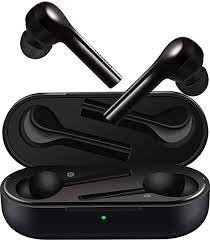HUAWEI was able to position itself in a very advantageous position. It offers a variety of audio products as a business. You like over-the-ear headphones, right? Take a look at FreeBuds Studio. Looking for a cozy set of ANC buds? Check out the FreeBuds 3 (and its replacement, the freebuds 4, which is what we’re looking at today). Do you desire both active and passive noise reduction? The solution is FreeBuds Pro.
The FreeBuds 4i and the freelance Pro, to name a couple, are only a couple of the many other products in their portfolio. They truly have some for every taste, need, and budget, even if we just listed the company’s flagship products in our enumeration above.
The FreeBuds 4 build on the popularity of the FreeBuds 3 by maintaining the general aesthetics and design tenets of the earbuds while making minor adjustments to outperform the forerunner. In the HUAWEI FreeBuds 4 review that follows, we’ll examine those as well as the finished product.
HUAWEI FreeBuds 4 specs
The FreeBuds 4 is slightly smaller than the FreeBuds 3, both when comparing the earbuds and the charging case. A single earbud has dimensions of 41.4 mm in height, 16,8 mm in breadth, and 18,5 mm in depth. It weighs only 4.1 grams. The charging case is pebble-shaped, has a diameter of 58 mm, a height of 21.2 mm, and weighs 38 grams (with the buds removed).
The same Kirin A1 chip, which also powers the company’s GT2-series of smartwatches, earbuds, and the FreeBuds Studio, is housed inside along with a slightly larger 14.3 mm driver. The minor overall size decrease had no negative effects on battery capacity, which was rated at 30mAh for each earbud and 410mAh for the charging case.
This year’s earphones have received an upgrade to Bluetooth 5.2 connectivity and have earned the IPX4 classification against splashes coming from all sides. Both the bone sensor and wireless charging, which were featured on the predecessor, have been removed, and there are no known intentions to offer a version that supports them in the future.
Design, build and fit
The design itself is stunning and much in keeping with what we’ve come to expect from HUAWEI in its high-end goods. There is nothing more to say about the finish, which is likewise excellent. The fact that HUAWEI chose an open-fit design for the FreeBuds Pro’s replacement this year reminds me why I’m so enthused about the FreeBuds Pro’s predecessor, the FreeBuds 3. Open-fit designs have advantages and disadvantages. If you don’t like in-ear canal earbuds (like the FreeBuds Pro and more recently, the FreeBuds 4i), you should look at these. We’ll talk about them later.
Due to the open-fit design, HUAWEI had more freedom to tailor the FreeBuds 4’s size and shape to comfortably fit the majority of ears. You eventually forget you are wearing them after a short while. Due to their lightweight and comfort, you can quickly get used to wearing them.
Two of the main advantages of an open-fit design are two. In the section that follows, we’ll talk about the drawbacks of ANC and audio quality. To start, we should point out that these are just drawbacks if you’re switching from an in-ear canal design. If open-fit is your specialty, you should disregard these purported drawbacks.


